Tom's Guide Verdict
With the best battery life we’ve ever seen and a Snapdragon 8 Gen 2 chipset that delivers best-in-class performance, it’s hard to beat the ROG Phone 7 Ultimate as a gaming device. But the Galaxy S23 Plus and OnePlus 11 offer more complete mobile experiences at the same price or less.
Pros
- +
Astounding multi-day battery life
- +
Among the best performing Android phones
- +
Bright, colorful display
- +
Good selfie camera
- +
Many gaming-centric features
Cons
- -
No telephoto lens
- -
Noticeable bezels on the display
- -
Only two Android OS updates promised
- -
Limited water resistance rating at this price
Why you can trust Tom's Guide
The Asus ROG Phone 7 wants to settle the debate on whether you need a dedicated gaming phone once and for all. Equipped with the best mobile silicon available for an Android phone, a design conceived with gamers in mind and — most impressively — the longest-lasting battery we've ever come across, the ROG Phone 7 ticks every box for what you'd want if your phone's primary task was to serve as a handheld gaming device.
For all the great features the ROG Phone 7 boasts — and it is an impressive phone — they're matched by what many top flagships offer, usually at or around the same price that Asus charges for its gaming-focused handset. And in the past, those phones have proven more adept than the ROG Phone at other things, such as mobile photography.
Does the ROG Phone 7 offer enough to make it the indisputable mobile choice for gamers? Or is a leading flagship phone still a better choice for the best gaming phone? That's what this Asus ROG Phone 7 review looks to decide.
Asus ROG Phone 7 Ultimate review: Specs
| Asus ROG Phone 7 | Asus ROG Phone 7 Ultimate | |
| Price | $999 | TBA |
| Screen size | 6.8-inch AMOLED (2448x1080) | 6.8-inch AMOLED (2448x1080) |
| Refresh rate | 165Hz | 165Hz |
| CPU | Snapdragon 8 Gen 2 | Snapdragon 8 Gen 2 |
| RAM | Up to 16GB | 16GB |
| Storage | Up to 512GB | 512GB |
| Rear cameras | 50MP main; 13MP ultrawide; 8MP macro | 50MP main; 13MP ultrawide; 8MP macro |
| Front camera | 32MP | 32MP |
| Battery size | 6,000 mAh | 6,000 mAh |
| Battery life (Hrs:Mins) | Not yet tested | 18:32 (Variable), 13:23 (165Hz) |
| Charging speed | 65W wired | 65W wired |
| Size | 6.8 x 3 x 0.4 inches (173 x 77 x 10.3mm) | 6.8 x 3 x 0.4 inches (173 x 77 x 10.3mm) |
| Weight | 8.4 ounces (239 grams) | 8.4 ounces (239 grams) |
| Colors | Storm White, Phantom Black | Storm White |
Asus ROG Phone 7 Ultimate review: Price and availability
Asus plans to charge $999 for the ROG Phone 7 when it becomes available sometime between now and the end of June. Asus also offers a ROG Phone 7 Ultimate, which is the unit I tested. There are some differences, such as design changes to the back of the phone and the amount of RAM you get. (My ROF Phone 7 Ultimate test unit had 16GB of RAM; the ROG Phone 7 can support that much RAM, but presumably, the base model comes with less.) In areas that matter — cameras, chipset, storage — the phones are identical, so anything I say about the ROG Phone 7 Ultimate goes for the ROG Phone 7.
There's one thing we don't know about the Ultimate model — how much it costs. We'll update this review once Asus makes that known, but I wouldn't expect it to be cheaper than the $999 ROG Phone 7 starting price.
To put the ROG Phone 7's price in context, that $999 starting price is what Samsung charges for the Galaxy S23 Plus. You can get an entry-level Galaxy S23 for $200 less and that phone has the same Snapdragon 8 Gen 2 chipset found in the ROG Phone 7, plus a telephoto lens — a feature missing from Asus' phone. The OnePlus 11, which also runs on a Snapdragon 8 Gen 2, is $300 cheaper than the ROG Phone 7.
Asus ROG Phone 7 Ultimate review: Design
It takes just a glance to see that the ROG Phone 7 is designed as a gaming device. Asus uses what it calls a Two Tone concept — on the standard ROG Phone 7 that means a matte finish on the bottom half and a translucent upper half with an illuminated ROG logo. You've got a choice between Storm White and Phantom Black on the ROG Phone 7 while the Ultimate model only comes in Storm White.
Get instant access to breaking news, the hottest reviews, great deals and helpful tips.
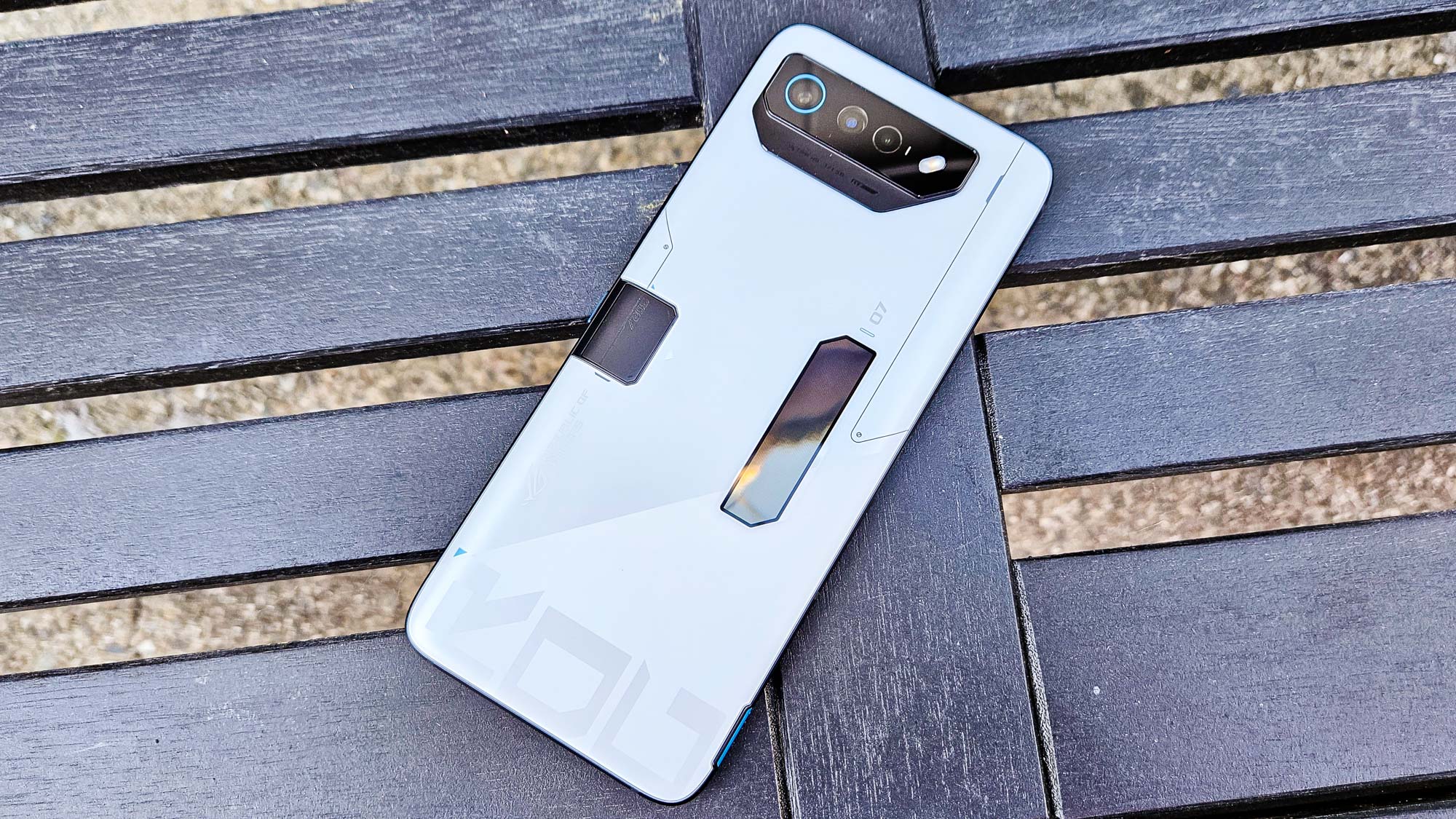
The look of the ROG Phone 7 Ultimate is slightly different, too, with an ivory shade of white on the bottom third of the phone adorned with the ROG logo stacked along the bottom edge. The upper two-thirds is more of a gray color. Instead of an illuminated logo, the Ultimate features a vertical OLED strip that can show alerts for incoming calls, when you're launching a game and more.
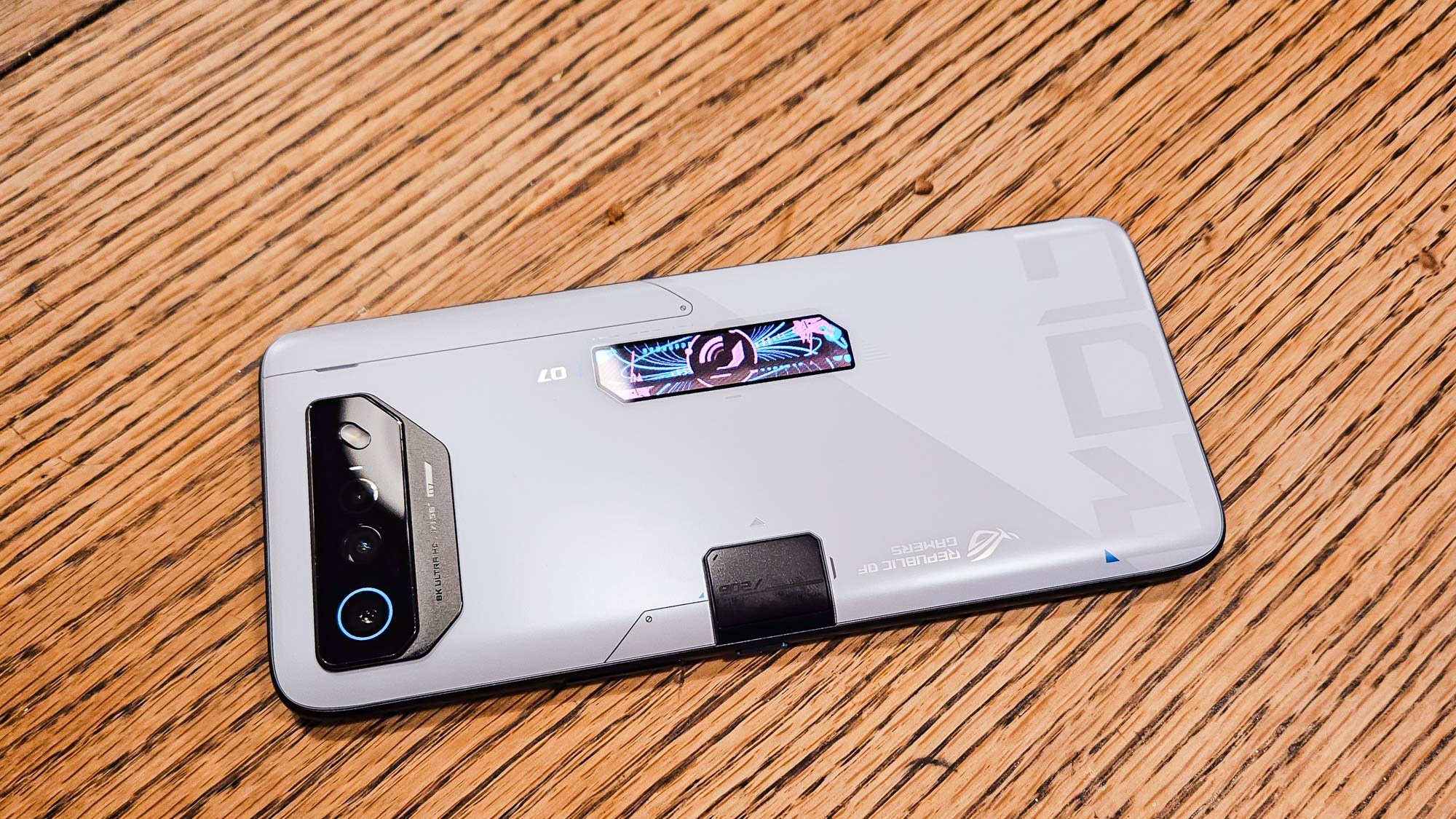
Like the Pixel 7 family, the ROG Phone 7 arranges its rear cameras horizontally, though the camera bar doesn't run the length of the phone. Instead, the lenses are housed in a kind of hexagon that sticks out from the back of the phone. Up front, the selfie cam is housed toward the right side of the phone in a bezel at the top of the display.
Make no mistake — the ROG Phone 7 is a big, thick phone. Whatever model you get, you're toting around an 8.4-ounce device that measures 6.8 x 3 x 0.4 inches. That can be a lot of phone to hold up when you're gaming, and because I'm dealing with a bout of tendonitis in my right wrist at the moment, I definitely felt the impact of gaming sessions afterwards. Still, it’s not that much heavier than the Samsung Galaxy S23 Ultra, which checks in at 8.2 ounces.
Two other design elements deserve attention here — one good, one bad. On the disappointing side of the scale, the ROG Phone 7 offers only IP54 water resistance, meaning it can withstand a splash of water, but not a dunk like IP68 phones can. Most devices that cost $1,000 or more are going to feature IP68 protection, so that's a miss on Asus' part.
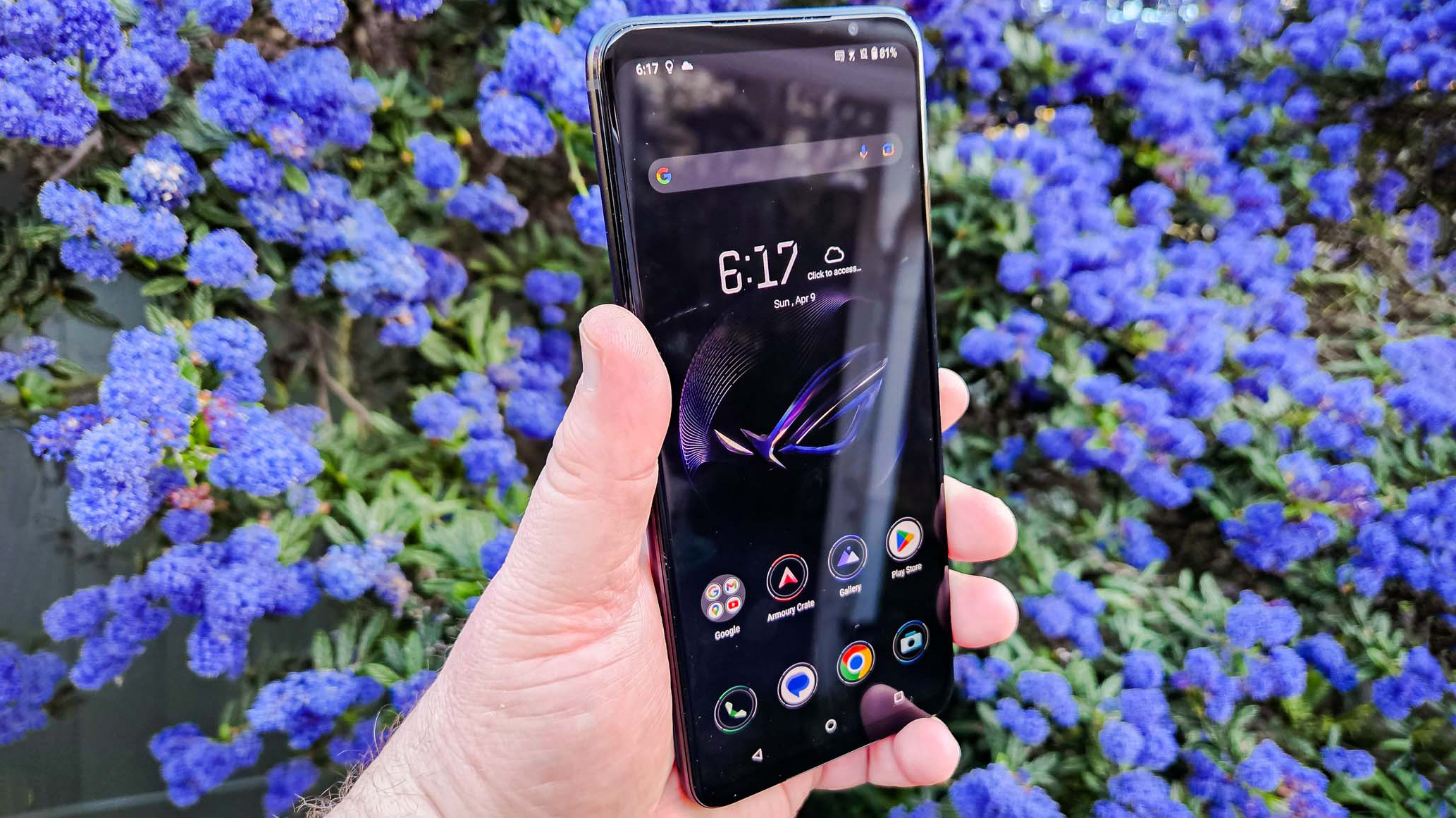
On the opposite end of the spectrum, the under-display fingerprint sensor on the ROG Phone 7 works tremendously well — it's responsive and easy to use. And call me a rube, but I love the animation that flashes around the sensor when you place your finger on it, followed by the whoosh that you hear as you unlock the phone. It really sets the mood for a gaming device.
Asus ROG Phone 7 Ultimate review: Display
Gaming phones demand big displays, and the ROG Phone 7 complies with a 6.8-inch AMOLED panel. (Technically, it's 6.78 inches, but what's a little rounding up among friends?) The 2448 x 1080 resolution could be a little sharper for my tastes, but gamers are certainly going to appreciate the 720Hz touch sampling rate and 23ms touch latency that make this screen respond to your taps, swipes and other rapid-fire gestures.
Fast-refresh rates are to be expected in phones of this nature, and Asus ups the stake with a 165Hz refresh rate designed for smoother scrolling and more immersive graphics in games that support such a feature. An Auto setting adjusts the refresh rate automatically, so that you can preserve battery life when the on-screen activity is a bit more static.
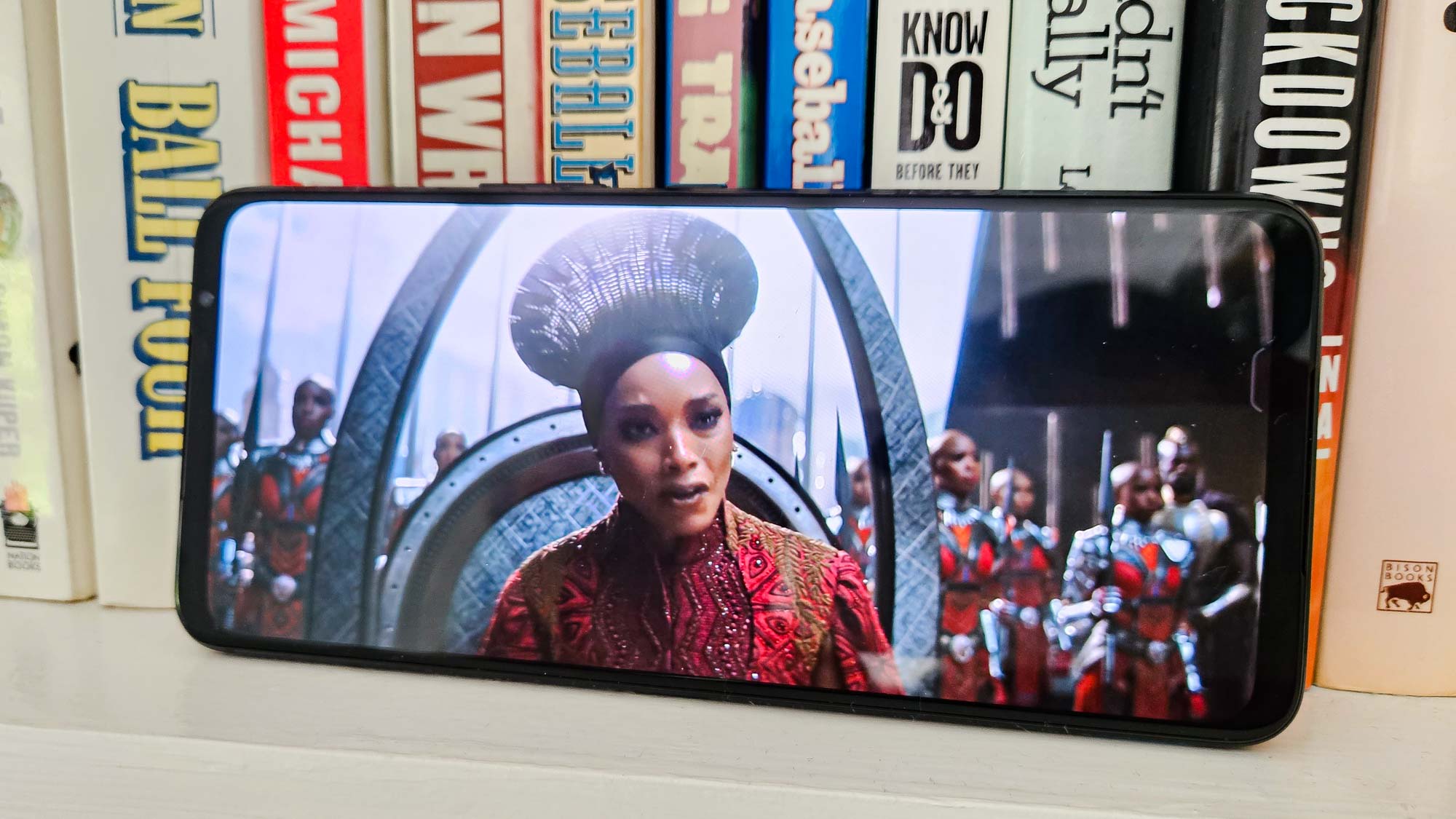
Asus promises a max brightness of 1,500 nits, though our testing didn't approach that. The highest reading we got with our light meter topped out at 960 nits. That's certainly bright enough to use the ROG Phone 7 in direct sunlight, but it's not going to outshine the 1,184 nit reading we got with the Galaxy S23 Ultra. Brightness also came into play during my gaming testing, as I detail below in the Performance section of this Asus ROG Phone 7 review.
| ROG Phone 7 Ultimate | Samsung Galaxy S23 Ultra | iPhone 14 Pro | |
| Display size | 6.8-inch AMOLED | 6.8-inch AMOLED | 6.1-inch OLED |
| sRGB (%) | 193.9% (Natural); 166.3% (Splendid Natural) | 193% (Vivid); 111.2% (Natural) | 119.8% |
| DCI-P3 (%) | 137.3% (Natural); 117.8% (Splendid Optimal) | 136.7% (Vivid); 78.8% (Natural) | 84.8% |
| Delta-E | 0.32 (Natural); 0.28 (Splendid Optimal) | 0.37 (Vivid); 0.30 (Natural) | 0.25 |
| Peak brightness | 960 nits | 1,184 nits | 993 nits |
When we set the ROG Phone 7's display to what Asus calls Natural Mode, the panel's ability to display colors was in line with the Galaxy S23 Ultra's display. The ROG Phone 7 Pro captured 193.9% of the sRGB color spectrum in Natural, while capturing 137.3% of the more demanding DCI-P3 spectrum. For context, the Galaxy S23 Ultra's respective numbers were 193% and 136.7% in Vivid Mode.
Switching to the Splendid Optimal setting on the ROG Phone 7 improved color accuracy, with the phone recording a Delta-E rating of 0.28 compared to 0.32 in Natural. (Numbers closer to zero are more accurate.) The S23 Ultra had a Delta-E rating of 0.30 in its Natural mode while the OnePlus 11 and iPhone 14 Pro proved to have the more accurate colors based on their Delta-E scores. (Both scored 0.24, with the OnePlus 11 posting that result in its Natural mode.)
Watching videos on the ROG Phone 7, I was satisfied with how vivid colors looked. Streaming Black Panther: Wakanda Forever on Disney Plus, Angela Bassett's various robes looked resplendent and Letitia Wright's Black Panther outfit was suitably ebony. The more vibrant Super Mario Bros. Movie trailer popped with color when I watched it on YouTube, particularly as Mario and friends raced down the Rainbow Road. The only disappointment are the noticeable bezels at the top and bottom of the phone, which in an era of edge-to-edge displays can make things seem cramped, if such a thing is possible on a 6.8-inch device.
Asus ROG Phone 7 Ultimate review: Performance
The Snapdragon 8 Gen 2 chipset is currently the top performing silicon for Android phones, so it makes sense that Asus would use this particular system-on-chip for its new gaming phone. The benchmark results speak for themselves as the ROG Phone 7 more than holds its own against some of the top performing Android phones.
| Phone | CPU | Geekbench single core/multicore results |
| ROG Phone 7 Ultimate | Snapdragon 8 Gen 2 | 1380 / 4817 |
| Samsung Galaxy S23 Ultra | Snapdragon 8 Gen 2 for Galaxy | 1578 / 5081 |
| OnePlus 11 | Snapdragon 8 Gen 2 | 1166 / 4962 |
| iPhone 14 Pro | A16 Bionic | 1891 / 5469 |
The ROG Phone 7's single- and multicore scores of 1,380 and 4,817 on Geekbench 5 traile the 1,578 and 5,081 numbers posted by the Galaxy S23 Ultra, though Samsung's phones run on a version of the Snapdragon 8 Gen 2 that's optimized for performance. The OnePlus 11, another Snapdragon 8 Gen 2-powered phone, posted a slightly better multicore score on Geekbench, though the ROG Phone 7 had the better single-core result of those two phones.
As you'd expect, these Android phones trail the latest iPhone 14 Pro models, though the Snapdragon 8 Gen 2 has closed the performance gap significantly.
| Phone | CPU | Wild Life Unlimited (FPS) |
| ROG Phone 7 Ultimate | Snapdragon 8 Gen 2 | 84 |
| Samsung Galaxy S23 Ultra | Snapdragon 8 Gen 2 for Galaxy | 87 |
| OnePlus 11 | Snapdragon 8 Gen 2 | 84 |
| iPhone 14 Pro | A16 Bionic | 74 |
| iPhone 14 Pro Max | A16 Bionic | 74 |
That performance holds up when we turn to graphics testing through 3DMark's Wilde Life Unlimited benchmark. The ROG Phone 7 posted an 84 frames per second result, matching the OnePlus 11's score while finishing just behind the 87 fps result that the Galaxy S23 Ultra put up. As has been the case with all the Snapdragon 8 Gen 2 phones we've tested, the ROG Phone 7 posted better numbers on this test than the A16 Bionic-powered iPhone 14 Pro models.
If there's one mild disappointment to our performance testing, it's that the pre-release version of the ROG Phone 7 was unable to run Adobe Premiere Rush, so we couldn't perform our real-world test in which we transcode a video and time the results. The Galaxy S23 Ultra has the best time of any Android phone in this test, completing the task in 39 seconds, so we're eager to see if the ROG Phone 7 can match that once software updates kick in to let Premiere Rush run unimpeded.
Asus ROG Phone 7 Ultimate review: Gaming performance
Still, we can get a sense of real-world performance just by playing games on the ROG Phone 7, and it's more than able to handle graphically intensive titles like Asphalt 9, PUBG Mobile and Genshin Impact, even when we switched from one game right to the other. I was particularly impressed with PUBG on the ROG Phone 7: the audio from my assorted weapons had a satisfying crackle over the front-firing speakers, and the graphics rendered smoothly without any glitches.
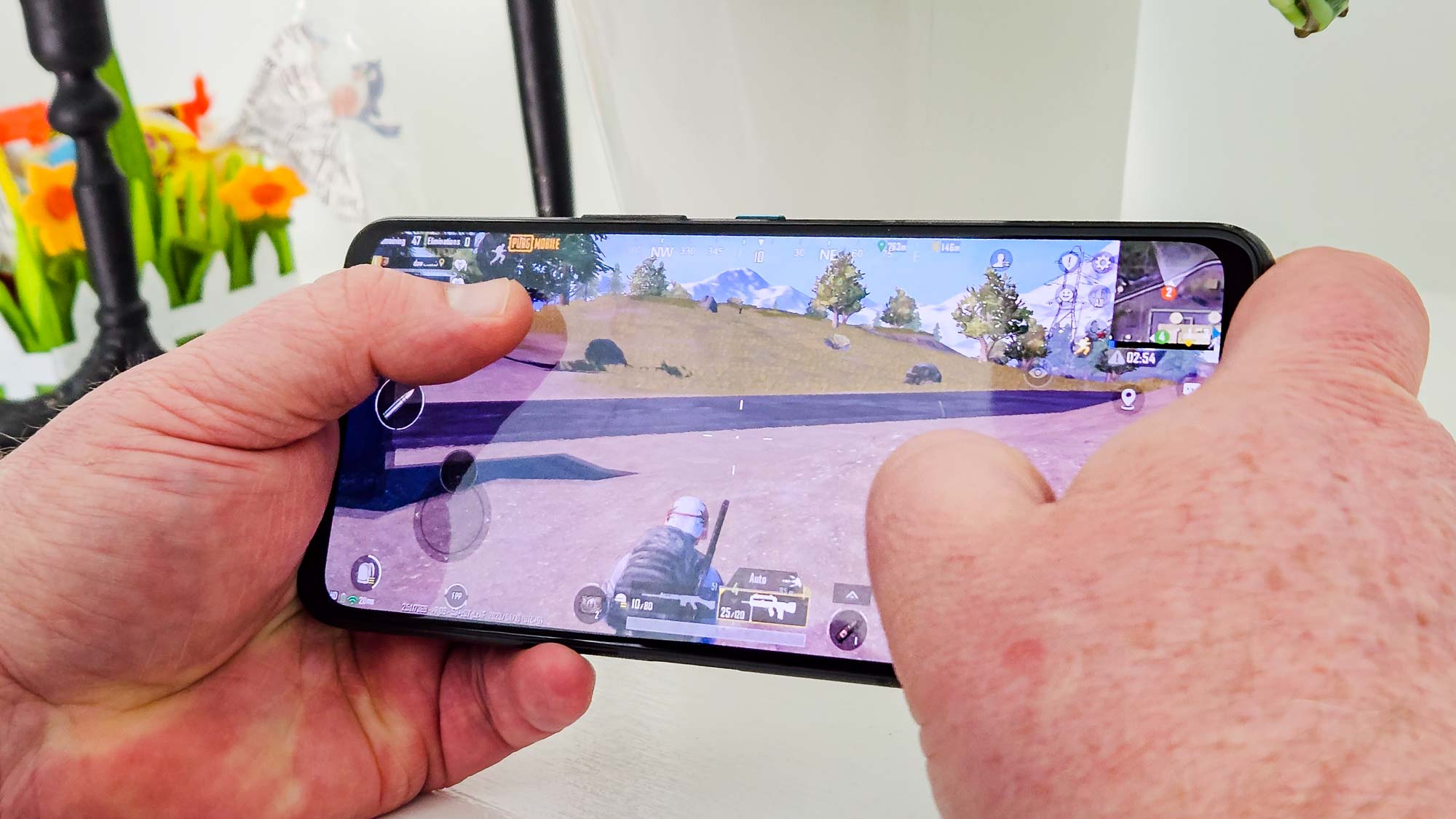
If I have a complaint about gaming on the ROG Phone 7, it relates to the phone's display. The 6.8-inch panel offers ample screen real estate, but I found things a little dim unless I fiddled with the display's settings — in PUBG, for example, I had a hard time spotting enemies off in the distance. Ramping up brightness while also turning off the adaptive display feature did the trick, but I wish the panel didn't require that kind of fiddling.
At least you don't have to worry about the ROG Phone 7 overheating and causing performance slowdowns during marathon gaming sessions. Asus made some improvements to the ROG Phone 7's cooling system with sustained performance in mind. For instance, the phone maker says there's a new design for the Rapid-Cycle Vapor Chamber design resulting in a 2.1x improvement in heat dissipation over traditional vapor chamber cooling. Since the ROG Phone 7 never got noticeably hot during my testing, I'll take Asus at its word here.
Asus ROG Phone 7 Ultimate review: Battery life and charging
One Asus ROG Phone 7 feature stands out above all others in our testing — the phone's phenomenal battery life. The phone relies on a pair of 3,000 mAh batteries to stay powered up. Splitting the battery up not only gives the ROG Phone 6,000 mAh of power to draw on, but Asus says it helps the phone produce less heat during those marathon gaming sessions. Throw in the Snapdragon 8 Gen 2's well-earned reputation for efficient power management, and you'd figure the ROG Phone 7 can hold out for a long time on a charge.
Throw in a "jaw-droppingly" in front of "long time," and you've accurately described the ROG Phone 7's performance on our battery test. We see how long phones can last by setting their display to 150 nits of brightness before having them surf the web over 5G until they run out of power. An average performance on that test is to run out of power just shy of 10 hours, while a truly long-lasting phone holds out for 11.5 hours or more.
The Asus ROG Phone 7 averaged a time of 18 hours and 32 minutes. That's a little better than 3 hours longer than the previous battery champ, which was last year's ROG Phone 6 Pro. So the ROG Phone 7 moves to the top of our best phone battery life list.
| ROG Phone 7 Ultimate | Galaxy S23 Ultra | iPhone 14 Pro Max | OnePlus 11 | |
| Battery size | 6,000 mAh | 5,0000 mAh | 4,323 mAh | 5,000 mAh |
| Battery life (Hrs:Mins) | 18:32 | 12:22 | 13:39 | 11:52 |
| Wired charging speed | 65W | 45W | 20W | 80W |
| Recharge percentage (15 mins) | 35% | 31% | 21% | 57% |
| Recharge percentage (30 mins) | 69% | 57% | 42% | 97% |
We should note that Asus' new gaming phone posted that time with its refresh rate set to automatic, meaning it would scale up to 165Hz when it determined that the on-screen content would benefit from a faster refresh speed. Locking that refresh rate at the power-hungry 165Hz setting ate into battery life, as you'd imagine, but the ROG Phone 7 still lasted 13 hours and 23 minutes. That still would have placed the Asus phone ahead of every device we've tested in the last 18 months save for the iPhone 14 Pro Max.
In everyday use, the ROG Phone 7 battery lasts more than a day. Our testing lab handed me a fully charged phone and after a couple of days that included a modest amount of gaming and photo capture tests, I still had a 50% charge left on the device. You're really going to have to work to drain the ROG Phone 7's battery.

You won't have to wait long for the Asus ROG Phone 7 to charge either, as the phone supports 65W charging and even ships with its own HyperCharger. We got a drained ROG Phone 7 to a 69% charge after 30 minutes. That's not as fast as the OnePlus 11, which almost fully charged after half-an-hour, but that phone supports 80W charging and has a smaller battery to top off. Flagships like the iPhone 14 Pro Max and Galaxy S23 Ultra reached 42% and 57%, respectively.
If a scenario rises where you need to charge up during a game, the ROG Phone 7 features a side-mounted USB-C charging port in addition to the one on the bottom of the phone. That allows you to keep gaming in landscape mode without having to wrap your hands around a charging cable.
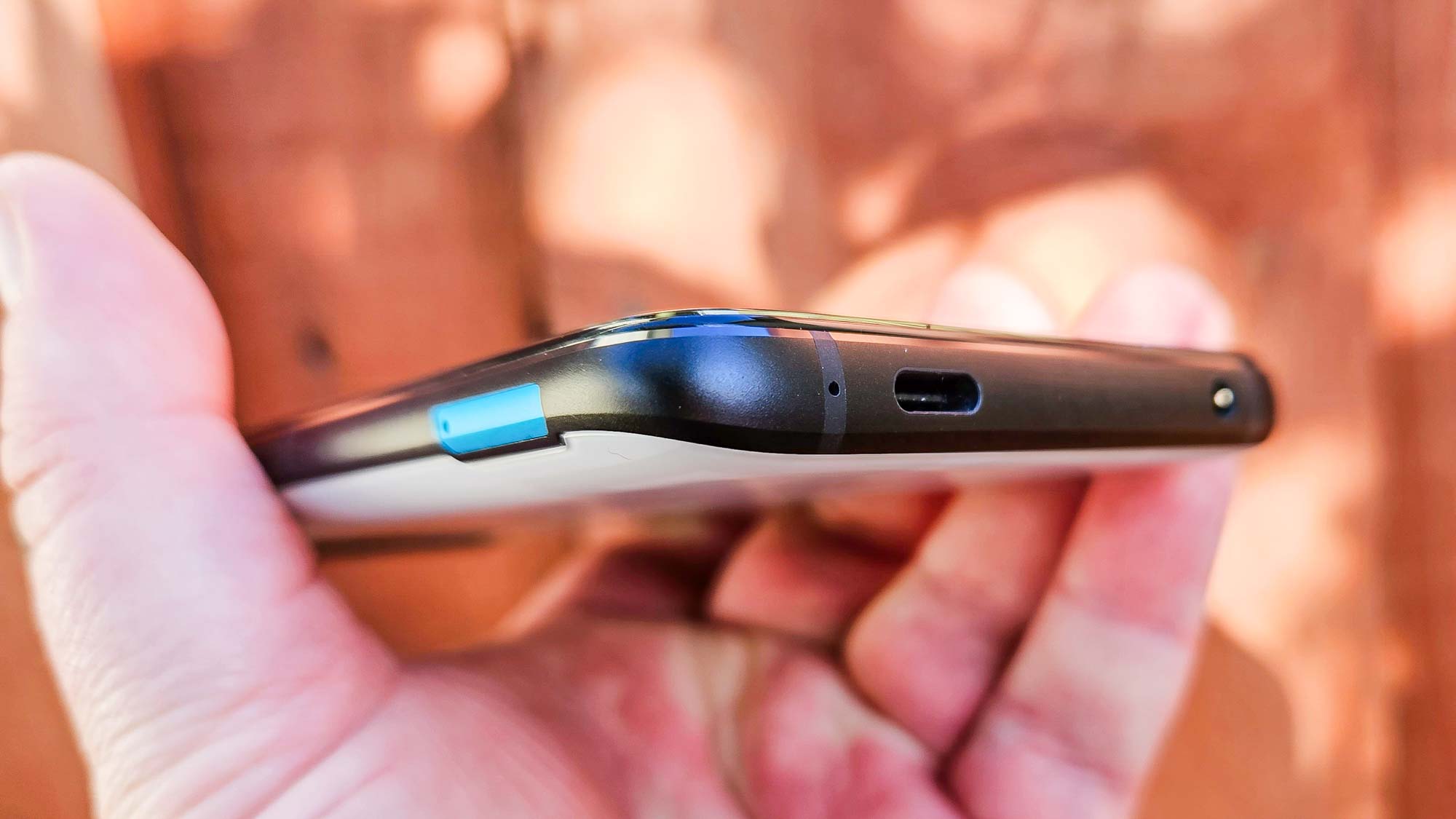
One other ROG Phone 7 battery feature that impressed me is the steps Asus has taken to extend the life of this device's battery. You can set a custom charging limit with an eye toward extending the battery's lifespan, while a scheduled charging feature reduces wear on the battery by keeping the power pack at a lower level overnight.
Asus ROG Phone 7 Ultimate review: Cameras
We normally evaluate cameras higher up in our phone reviews, giving the importance of mobile photography to most smartphone owners. Having the best camera phone is less of a consideration to gaming phone owners, though, as big screens, long-lasting batteries and chipsets that can handle demanding graphics are far bigger concerns.
That said, you want a smartphone that's at least capable of taking decent photos, especially for what you're paying for the ROG Phone 7. To that end, Asus has equipped this phone with a 50MP main camera and a 13MP wide-angle lens. While most phones that start around $1,000 would include a telephoto lens, too, that camera is MIA from the ROG Phone 7; instead, an 8MP macro lens serves as the phone's third rear camera.
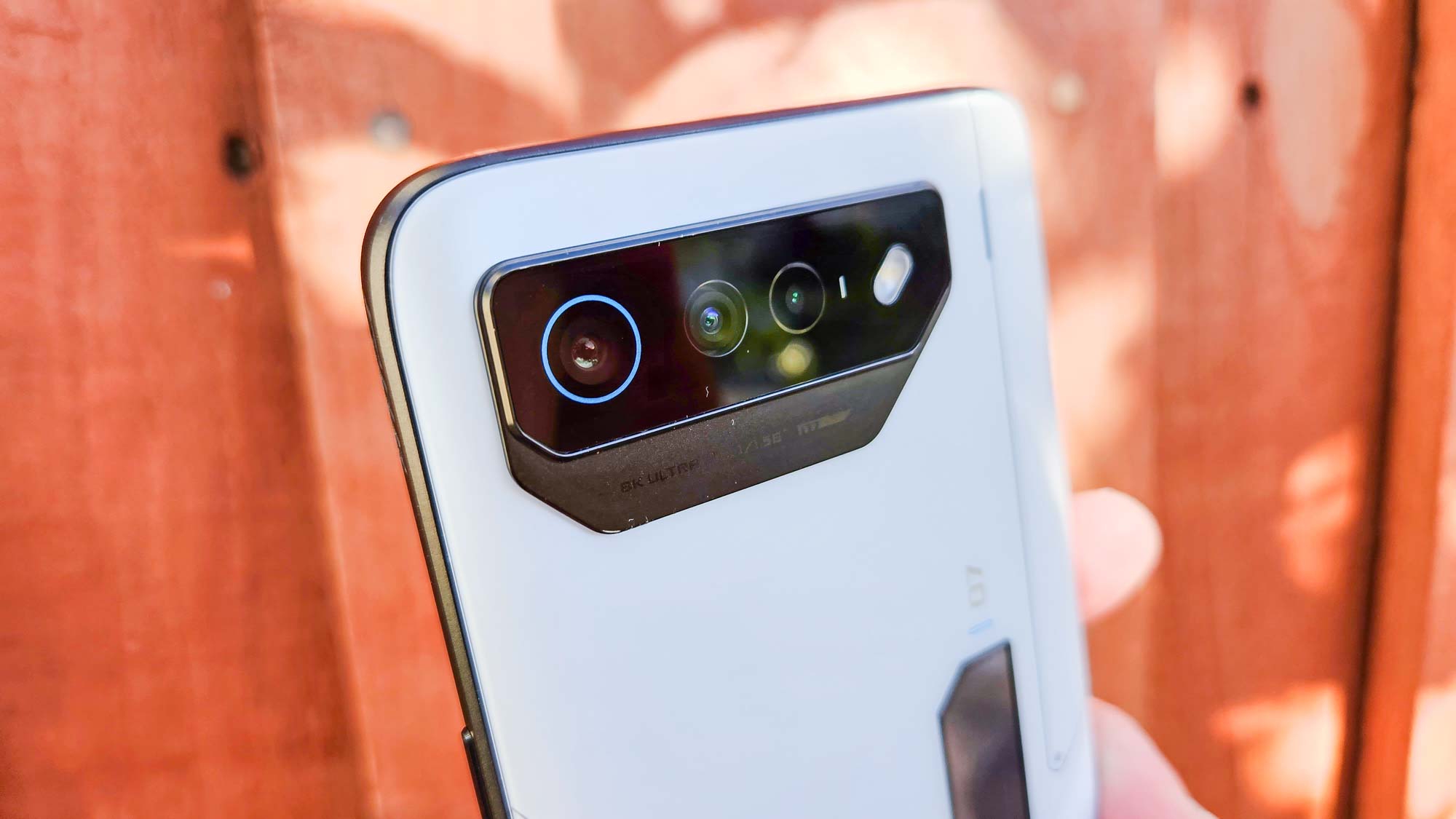
From that hardware, you'd expect solid if not spectacular shots, and that's what the ROG 7 Phone provides for the most part. The cameras will get the job done, though not as ably as phones that come equipped with more impressive specs — including a few that actually cost less than Asus' phone.
You can immediately see how the ROG Phone 7's cameras fall short of what a flagship device like the Samsung Galaxy S23 offers in this shot of some carnations. The ROG Phone 7 captures the different shades of purple, but the visuals don't pop. There's a fuzziness to the image, too, which I'd attribute to the dimming sunlight in the room.
That challenging light wasn't an issue for the Galaxy S23, which reproduces a clean, focused shot of the scene. The purples are darker and richer, too, and even the pink and green candles stand out in this shot.
There's more than enough sunlight for the ROG Phone 7 when I took a shot of a local mural. As a result, the ROG Phone 7's version looks much more accurate than what the S23 captured, as its shot showcases the tendency of Galaxy phones to over-saturate colors. In this case, though, the deeper colors are more eye-catching, and you'd have to concede it's the more attractive photo, accurate or not.
The cameras reverse their tendencies when I switched to the ultrawide lens, with the ROG Phone 7 Pro taking the darker shot of this wall of baseball memorabilia. I think the darker coloring of the ROG Phone shot is more striking, even if the S23 photo offers a more consistent tone. The darker colors make the World Series replica ticket in the ROG Phone shot easier to read at a distance.
To try out the night mode, I went down into my basement to photograph some Halloween decorations hanging in a workshop area. There's no color to the ROG Phone 7 shot — it's still very gray and shadowy, and the objects on the shelves behind the skeletons don't really emerge from the darkness. The Galaxy S23 photo has a blue tint to it overall, making things overly cool, but at least the skeletons look whiter and the overall photo is more detailed. I simply don't think the ROG Phone 7 performs that well in low light.
The portrait shot taken by the ROG Phone 7 is a decent one, to a point. Asus' phone doesn't crop in closely as the Galaxy S23 does in portrait mode, so in the full shot, you get more of the background. That leaves more opportunities where the bokeh effect isn't consistently applied, and that's in evidence in the area above my daughter's head in the ROG Phone 7's effort.
More troubling, my daughter looks overly pale in the ROG Phone 7's portrait. The Galaxy S23 manages to highlight some color in her cheek, so that you're not left with the impression that I'm keeping her in an attic like in a Victorian novel.
The ROG Phone 7's 32MP front camera is certainly up to the task of capturing selfies — in fact, it delivered the most consistent performance of any ROG Phone camera during my testing. While my baseball cap is casting a shadow over my face in the ROG Phone's shot, the rest of the photo is pretty well-balanced with good colors from the lemon tree behind me and the patch of blue sky at the top of the photo. The S23 makes my face look overly ruddy, a common occurrence when phones get too aggressive adjusting skin tone.

I can take or leave macro cameras — mostly, I'd prefer to leave them — but I have to give credit to the 8MP sensor that Asus includes on the ROG Phone 7. It manages a fairly detailed close-up of some California lilacs growing in my backyard. You see a hint of fuzziness in some regions of the photo, but for the most part, the shot remains in the focus — something I can't always count on with other macro lenses.
In terms of video, the ROG Phone 7 captures 8K video at 24fps while slow motion video works at 120fps for 4K video and 480fps for HD. Electronic image stabilization keeps your footage steady while an HDR video feature can improve video quality for light and dark settings in some cases.
Asus ROG Phone 7 Ultimate review: Software and special features
The ROG Phone 7 ships with Android 13 using the Asus Zen UI interface. It's a pretty clean take on Android, mostly adorned with features aimed at shoring up the ROG Phone's gaming bona fides. Those gaming-centric touches include themes and wallpapers tied to games like Call of Duty, The Walking Dead and Figure Fantasy, among others.
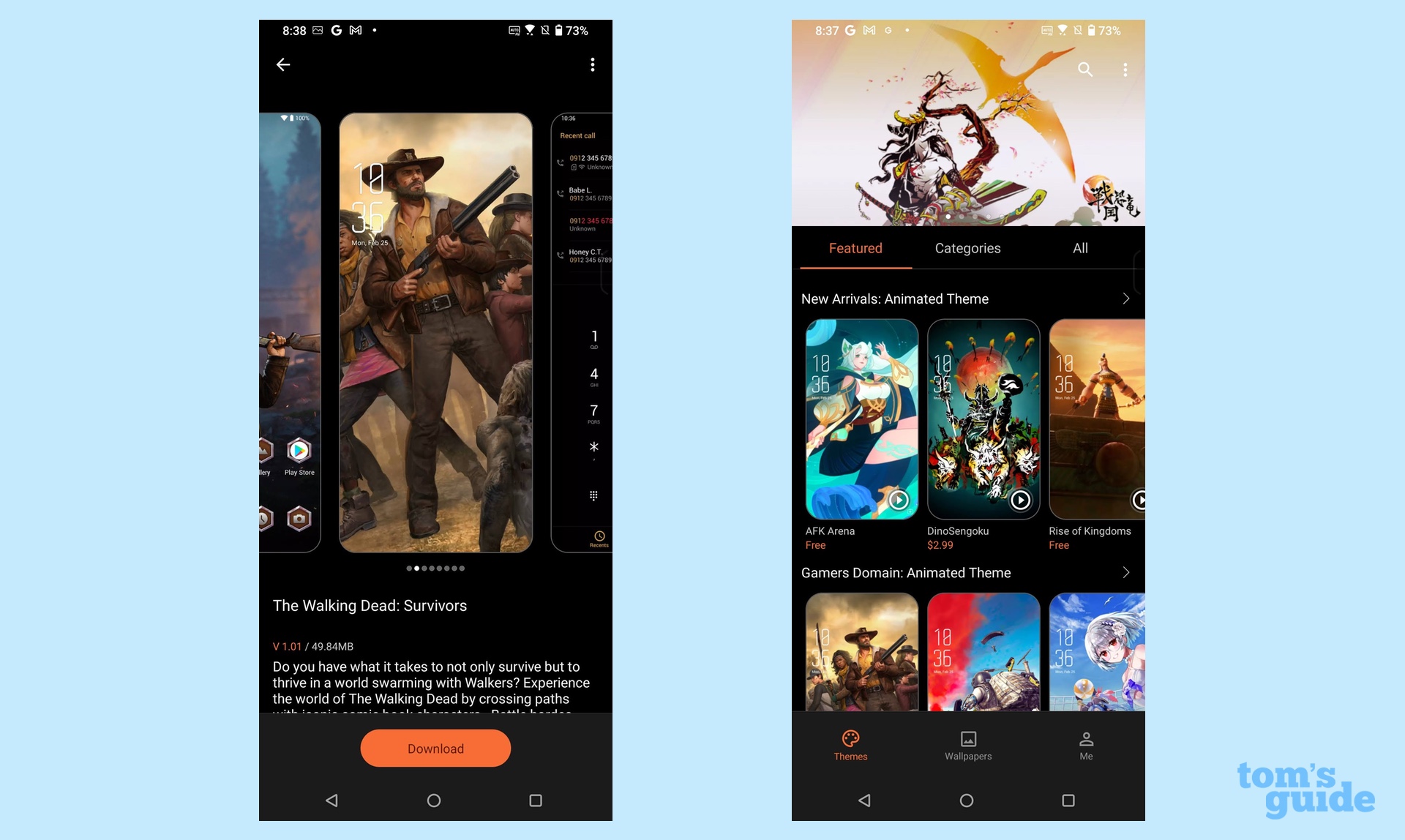
An included Armoury Cart app looks to create a console-like experience for managing your game library and customizing settings for each game. A new Graphics Boost panel lets you tune different graphical settings for specific games.
I'm sure gamers will appreciate these ROG Phone 7 features, just as I'm convinced they'll be less enamored with Asus' limited software support. You get two Android OS updates with the ROG Phone 7, which means after Android 15 drops in late 2024, you're on your own. At least Asus provides four years of security updates, but at a time when Samsung offers four years of Android updates for its midrange and flagship phones, that's pretty paltry support for a $999 device.
Asus ROG Phone 7 Ultimate review: Verdict
If you think of a smartphone as little more than a handheld gaming device that also takes phone calls, you'll find the ROG Phone 7 Ultimate (or the regular ROG Phone 7) pretty appealing. The Snapdragon 8 Gen 2 chipset delivers best-in-class performance, the screen is bright and colorful and I can't get over that 18-hour battery life.
The flaws begin to appear when you consider the ROG Phone 7 more as a smartphone instead of a gaming device. The cameras are adequate at best, software support is minimal and features you'd expect from a high-end flagship phone like extended software support or IP68 water resistance simply aren't there.
For the price Asus has set, you might be better off turning to phones like the OnePlus 11 or Galaxy S23 Plus, which run on the same processor as the ROG Phone 7, deliver impressive battery life in their own right, and also have better cameras. Certainly, there are more complete phones out there than the ROG Phone 7, though as far as gaming-only features are concerned, this Asus phone stands out.
Philip Michaels is a Managing Editor at Tom's Guide. He's been covering personal technology since 1999 and was in the building when Steve Jobs showed off the iPhone for the first time. He's been evaluating smartphones since that first iPhone debuted in 2007, and he's been following phone carriers and smartphone plans since 2015. He has strong opinions about Apple, the Oakland Athletics, old movies and proper butchery techniques. Follow him at @PhilipMichaels.


